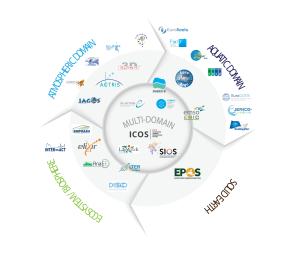Research Infrastructures
The term ‘Research Infrastructures’ refers to facilities, resources and related services used by the scientific community to conduct top-level research in their respective fields, ranging from social sciences to astronomy, genomics to environmental sciences.
Research Infrastructures in the Environmental research are crucial pillars for environmental scientists in their quest for understanding and predicting the complex Earth System. Originally, the Research Infrastructure facilities were developed to respond to the needs from specific research communities, following the individual needs and methods of specific disciplines. Disciplinary oriented research communities and Research Infrastructures collaborated with the neighbouring disciplines normally within the same “sphere” as within the atmosphere, biosphere, hydrosphere and geosphere. These communities are called “the four environmental domains” in the context of ENVRIplus.
Internal cooperation within different domains created diverse research traditions, specific skills and cultures. However, the interlinked nature of the Earth System requires the scientific community to transcend the well-established and familiar boundaries of disciplines and domains, and work towards common holistic understanding of the environment as a one Earth system.
ENVRIplus gathers all domains of Earth system science – Atmospheric domain, Marine domain, Biosphere and Solid Earth domain to work together, capitalize the progress made in various disciplines and strengthen interoperability amongst Research Infrastructures and domains.
This figure illustrates the Research Infrastructures directly participating in ENVRIplus. They represents different domains of the Earth System, with some of them having multi-domain approach. The inner grey circle shows RIs in the ESFRI 2010 Roadmap.





























![emphasis-logo[1]](https://www.envriplus.eu/wp-content/uploads/2015/08/emphasis-logo1.jpg)